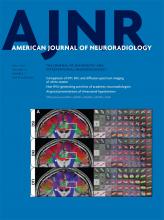Research ArticleAdult Brain
Time-of-Flight MR Angiography for Detection of Cerebral Hyperperfusion Syndrome after Superficial Temporal Artery–Middle Cerebral Artery Anastomosis in Moyamoya Disease
K. Sato, M. Yamada, H. Kuroda, D. Yamamoto, Y. Asano, Y. Inoue, K. Fujii and T. Kumabe
American Journal of Neuroradiology July 2016, 37 (7) 1244-1248; DOI: https://doi.org/10.3174/ajnr.A4715
K. Sato
aFrom the Departments of Neurosurgery (K.S., M.Y., H.K., D.Y., K.F., T.K.)
M. Yamada
aFrom the Departments of Neurosurgery (K.S., M.Y., H.K., D.Y., K.F., T.K.)
H. Kuroda
aFrom the Departments of Neurosurgery (K.S., M.Y., H.K., D.Y., K.F., T.K.)
D. Yamamoto
aFrom the Departments of Neurosurgery (K.S., M.Y., H.K., D.Y., K.F., T.K.)
Y. Asano
bDiagnostic Radiology (Y.A., Y.I.), Kitasato University School of Medicine, Sagamihara, Kanagawa, Japan.
Y. Inoue
bDiagnostic Radiology (Y.A., Y.I.), Kitasato University School of Medicine, Sagamihara, Kanagawa, Japan.
K. Fujii
aFrom the Departments of Neurosurgery (K.S., M.Y., H.K., D.Y., K.F., T.K.)
T. Kumabe
aFrom the Departments of Neurosurgery (K.S., M.Y., H.K., D.Y., K.F., T.K.)

REFERENCES
- 1.↵
- Suzuki J,
- Takaku A
- 2.↵
- 3.↵
- Fujimura M,
- Shimizu H,
- Inoue T, et al
- 4.↵
- Kaku Y,
- Iihara K,
- Nakajima N, et al
- 5.↵
- Uchino H,
- Kuroda S,
- Hirata K, et al
- 6.↵
- Fujimura M,
- Shimizu H,
- Mugikura S, et al
- 7.↵
- Horie N,
- Morikawa M,
- Morofuji Y, et al
- 8.↵
- 9.↵
- 10.↵
- Sato K,
- Kurata A,
- Oka H, et al
- 11.Research Committee on the Pathology and Treatment of Spontaneous Occlusion of the Circle of Willis; Health Labour Sciences Research Grant for Research on Measures for Intractable Diseases. Guidelines for diagnosis and treatment of moyamoya disease (spontaneous occlusion of the circle of Willis). Neurol Med Chir (Tokyo) 2012;52:245–66 doi:10.2176/nmc.52.245 pmid:22870528
- 12.↵
- Piepgras DG,
- Morgan MK,
- Sundt TM Jr., et al
- 13.↵
- 14.↵
- Fujimura M,
- Inoue T,
- Shimizu H, et al
- 15.↵
- 16.↵
- 17.↵
- 18.↵
- 19.↵
- Kohama M,
- Fujimura M,
- Mugikura S, et al
- 20.↵
- Greenberg JH,
- Kushner M,
- Rango M, et al
- 21.↵
- Naylor AR,
- Merrick MV,
- Slattery JM, et al
In this issue
American Journal of Neuroradiology
Vol. 37, Issue 7
1 Jul 2016
Advertisement
K. Sato, M. Yamada, H. Kuroda, D. Yamamoto, Y. Asano, Y. Inoue, K. Fujii, T. Kumabe
Time-of-Flight MR Angiography for Detection of Cerebral Hyperperfusion Syndrome after Superficial Temporal Artery–Middle Cerebral Artery Anastomosis in Moyamoya Disease
American Journal of Neuroradiology Jul 2016, 37 (7) 1244-1248; DOI: 10.3174/ajnr.A4715
0 Responses
Time-of-Flight MR Angiography for Detection of Cerebral Hyperperfusion Syndrome after Superficial Temporal Artery–Middle Cerebral Artery Anastomosis in Moyamoya Disease
K. Sato, M. Yamada, H. Kuroda, D. Yamamoto, Y. Asano, Y. Inoue, K. Fujii, T. Kumabe
American Journal of Neuroradiology Jul 2016, 37 (7) 1244-1248; DOI: 10.3174/ajnr.A4715
Jump to section
Related Articles
- No related articles found.
Cited By...
- No citing articles found.
This article has not yet been cited by articles in journals that are participating in Crossref Cited-by Linking.
More in this TOC Section
Adult Brain
Pediatric Neuroimaging
Similar Articles
Advertisement











